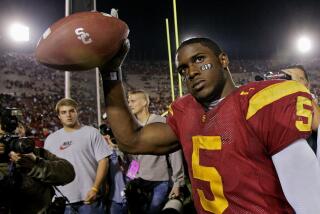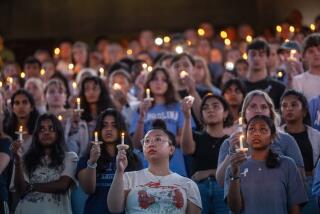Shots Fail to Fell This Nittany Lion : Football: Penn State defensive tackle Chris Mazyck, a shooting victim in 1991, is an inspiration to his teammates after courageous fight to regain his place on team.
- Share via
STATE COLLEGE, Pa. — When the gunfire stopped, Chris Mazyck lay on the pavement, blood gushing from six bullet holes in his left leg, groin and buttocks.
It was 2:30 a.m., March 9, 1991, in Columbia, S.C.
Mazyck, (pronounced: Ma- zeek ), a Penn State football player, had been shot at point-blank range with a .45 automatic, by a man he had ordered off his front porch about an hour earlier.
At first, he remembers, there was no pain, only shock. He had been knocked to the pavement by the first round.
The shooter continued firing.
Mazyck looked up to see his attacker put the handgun back in the waistband of his pants and run to his car, where a second man, the driver, waited.
Not knowing if he was bleeding to death, or if he would ever walk again, Mazyck watched his attacker’s car drive away--and memorized the license plate.
“It was just an instinctive thing to do,” he said Thursday. “I didn’t know this guy from a can of paint, but I knew someone could find him if I remembered that plate.”
It was a Florida plate, on a stolen rental car that soon was ditched. Months later, Mazyck’s attacker was caught--but not for the shooting.
On his rap sheet were murder and drug dealing, among other offenses. He had begun serving a 10-year sentence in North Carolina when another inmate reported to guards that the new guy had bragged about shooting a football player.
Mazyck, 6 feet 3 and 285 pounds, will start at defensive left tackle Saturday afternoon when Penn State plays USC at Beaver Stadium. He’s a sixth -year senior, with a degree in administration of justice. A graduate student, he plans to enter law school.
And he still has six slugs in his body.
After reviewing the case, the NCAA granted Penn State’s petition for an extra year for Mazyck. One of the South’s most widely recruited players after his 1988 prep senior season, he signed with Penn State and was a redshirt freshman in 1989.
He played in 1990, then was gunned down the next spring. He spent the 1991 and 1992 seasons recovering, then played in nine games last season.
He was accorded a wild sideline greeting by his teammates in Penn State’s Big Ten finale against Michigan State last year, when he made two consecutive game-saving sacks.
To everyone in Penn State football, the Mazyck story defines all the words coaches have turned into cliches-- courage, character, perseverance . . . .
“It’s unlike Coach (Joe) Paterno to single players out, he just doesn’t like to,” said Ki-Jana Carter, Penn State’s star running back.
“At first, when Chris came back to school and said he’d play again, we encouraged him . . . but after we saw that leg, we all thought, ‘No way.’
“But he got real focused, worked hard in the weight room, and he did it. Coach Paterno talked about ‘the warrior spirit’ at one team meeting, meaning Chris.
“Then he singled out Chris, and said he should be an inspiration to all of us who think we have problems in our lives.”
Mazyck shrugs.
“I don’t mind talking about it,” he says. “And if telling my story helps show people you can overcome adversity, great. But if I had to be a hero, I wish I could have done it without getting shot.
“One thing I’ve always felt in this thing is that I wouldn’t have done anything differently. I mean, what if I’d let my sister go out with those two guys? What would have happened to her?”
*
March 9, 1991, 1:30 a.m.
At the Mazyck family home on Quail Hills Drive, there’s a knock at the front door.
Mazyck, who is home from Penn State on spring break, answers the door.
“There was a little guy there, about 5-7, and I remembered seeing another guy in a white car parked out front,” Mazyck said.
“He told me he wanted to take my 16-year-old sister, Tauwana, out. I told him no and to leave. He gave me sort of a cold, hard stare, then he left, without saying a word.
“A half-hour later, I had to take my fiancee home. On the way back to my house, at about 2:30 a.m., I heard a funny sound from my rear end, like I might have a bad spring. So I pulled into a gas station that was closed, but it had enough lights so that I could take a look at it.
“I’d just gotten the car jacked up and was about to get under it when I heard a car skid to a stop at the stoplight. I looked at it, and it was the white car. The back-up lights came on and it screeched into the parking lot in reverse, where I was. They’d seen me.
“The little guy got out of the car and started walking toward me, but since I couldn’t see his gun, I wasn’t worried. I just stood there, looking at him. He stopped about five yards away and said, ‘Why did you talk such . . . to me?’
“I started to answer, then he pulled the gun out and started shooting.”
After the shooting, Mazyck got up from a pool of blood and began walking to a convenience store across the street.
“I knew I needed help, fast,” he said. “I got to within a few yards of the door, when I collapsed. My leg broke at that point. When I looked down, my leg above my knee was going in the wrong direction.
“Just then, a guy who was a friend of my brother’s walked out with a loaf of bread. He saw me, put me in his car, and got me to a hospital.”
That night, while emergency room doctors tried to stop his bleeding, they put 23 pints of blood back into his perforated body.
“He nearly died that night,” said Wayne Sebastianelli, Penn State’s director of athletic medicine.
There was a 48-hour period there where there was some question if they could save his leg.
“After 24 hours, they knew they’d saved his life. But the leg was another matter. The one bullet wound . . . was a global-like wound, with massive tissue damage.”
Then came the longest ordeal of the comeback--the healing.
Mazyck’s leg was immobile for eight months, and he spent the first few months of his recovery in a wheelchair.
“That was the hardest part for him, getting the flexibility and mobility back to his knee that he’d lost, while the leg was immobilized,” Sebastianelli said. “Also, there was a long recovery from the surgery, when they put a steel plate in him to secure the (thigh bone).”
Mazyck’s left leg is a maze of scarred bullet and drain holes, and the most visible mark of all is a knee-to-hip zipper from the thigh surgery.
A year later, he was back at Penn State, limping, but otherwise walking unaided. Could he still play football?
“Yeah, I did have some doubts,” he said. “ . . . Once I decided to quit thinking about it all and just get in the weight room and get busy, it wasn’t all that bad.”
By the spring of 1993, Mazyck was fit enough for spring football practice, but Paterno held him out, just to be sure. He played last season.
Mazyck is a quiet man, but says he has to do a lot of talking at airports.
“The metal detectors start going off about when I get off the bus,” he said.
“Sometimes, they don’t believe me, so I have to show them all the scars.”
More to Read
Go beyond the scoreboard
Get the latest on L.A.'s teams in the daily Sports Report newsletter.
You may occasionally receive promotional content from the Los Angeles Times.










